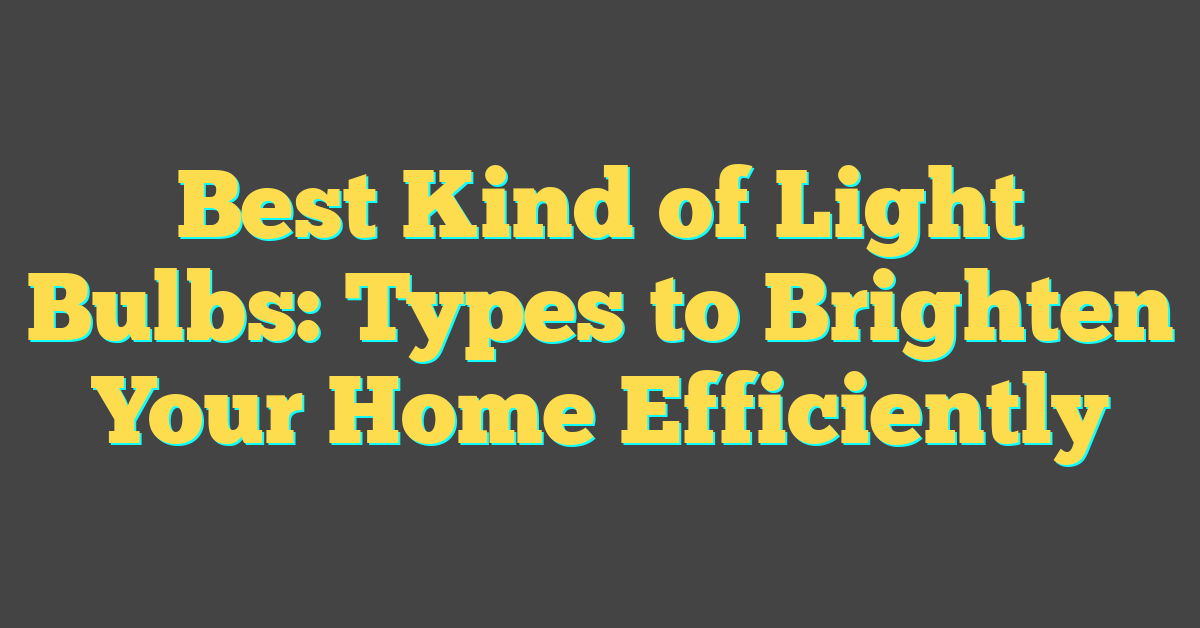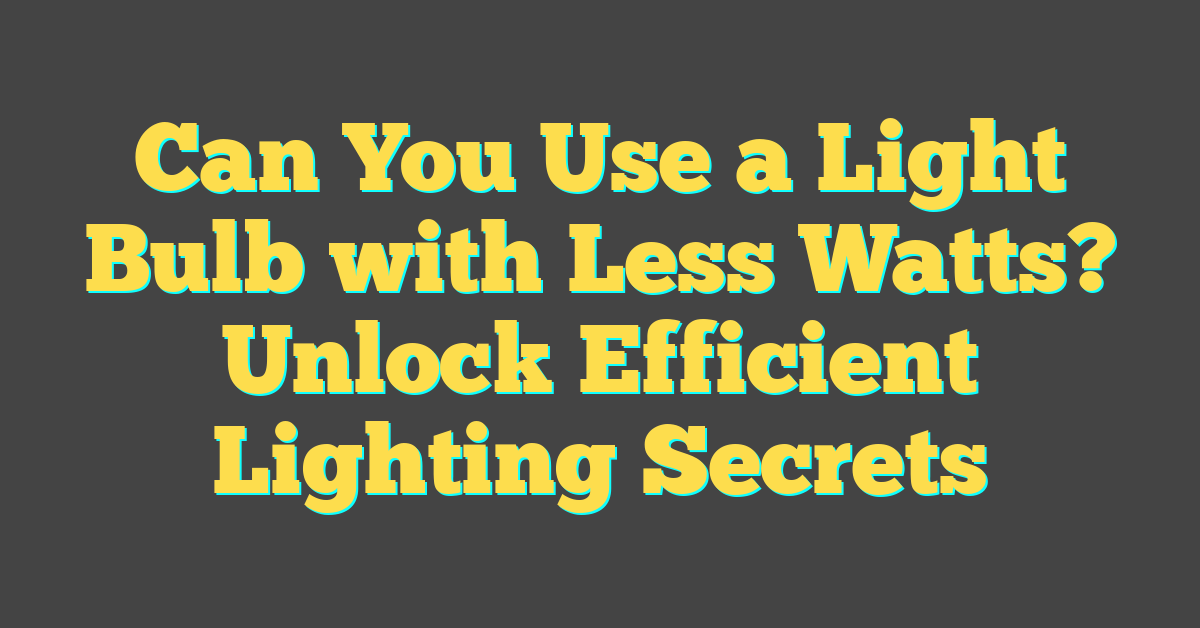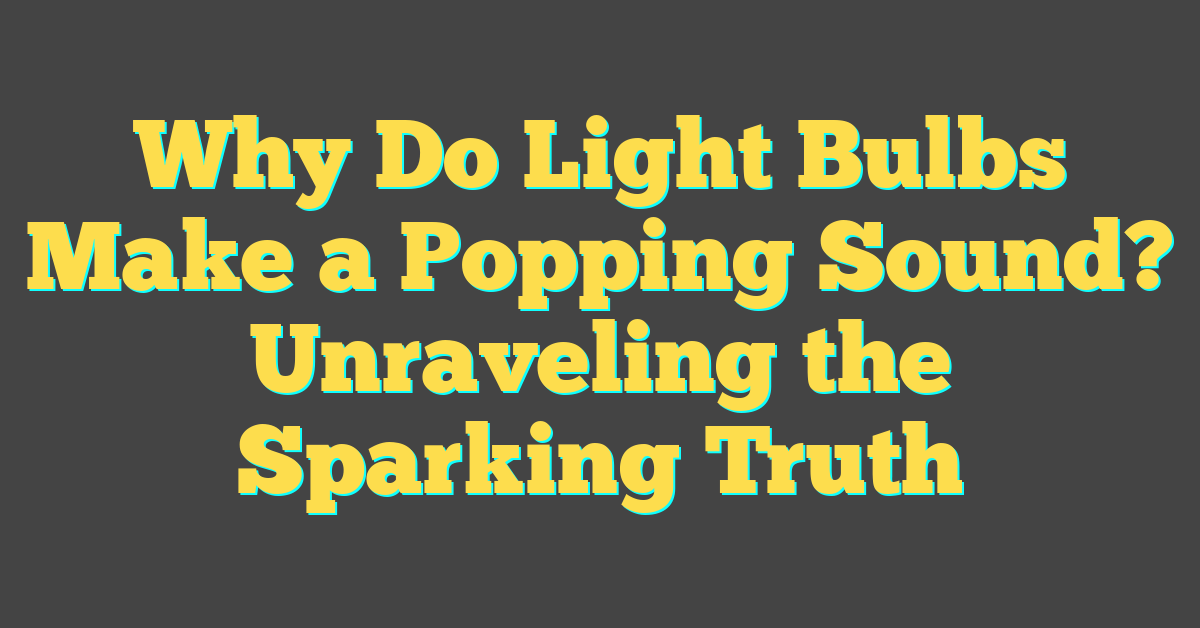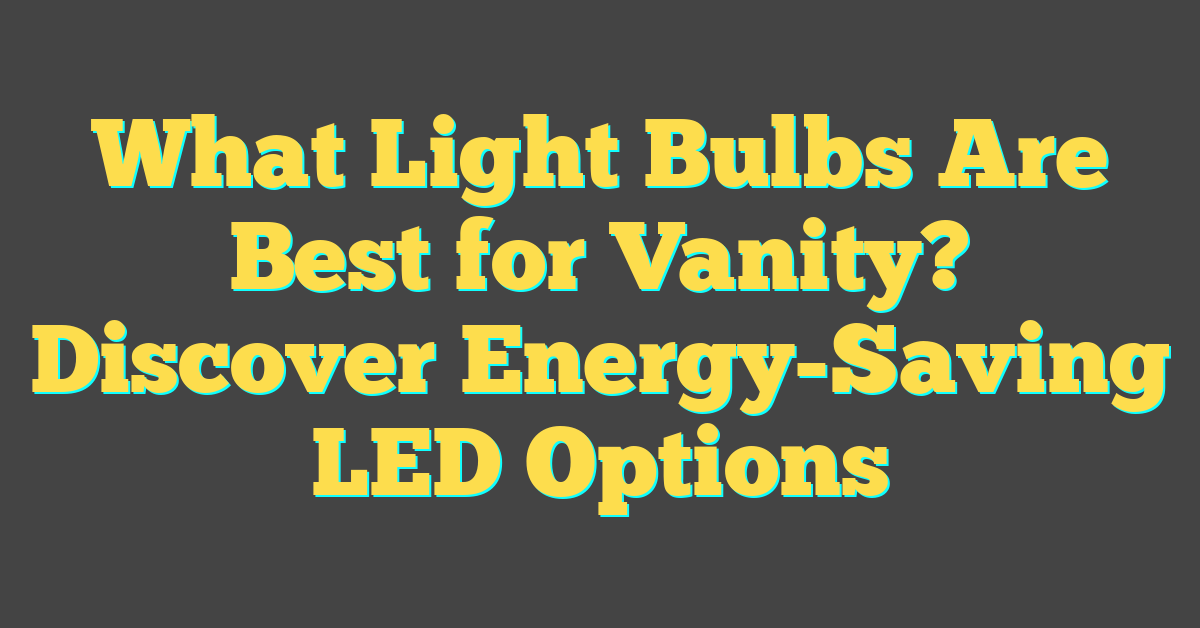Selecting the best kind of light bulbs for your home isn’t just a matter of preference or price. It’s about understanding the different technologies available and how they can enhance your living space, save on energy bills, and reduce environmental impact. The world of lighting has evolved far beyond the simple incandescent bulbs to include a variety of types such as LED, halogen, CFL, and smart bulbs. Each offers distinct benefits, whether it’s longevity, energy efficiency, or the quality of light.


As you consider upgrading or replacing your light bulbs, you’ll encounter terms like lumens, watts, and Color Rendering Index (CRI). It’s crucial to comprehend these concepts to make informed decisions that affect both the ambiance of a room and your utility costs. Modern lighting solutions also offer features like dimmability and connectivity to smart home systems, providing you with more control and customization than ever before. When choosing lighting for different rooms, consider the bulb’s color temperature and intended use to create the desired mood and functionality.
Key Takeaways
- Light bulbs vary in type, efficiency, and the quality of light they produce.
- Features like dimmability and connectivity can enhance home lighting control.
- Choosing the right bulb involves considering room function and energy usage.
Understanding Light Bulb Basics
https://www.youtube.com/watch?v=Ei5vS-g4DTo&embed=true
Selecting the right light bulb is essential for creating the desired ambiance and functionality in your space. It’s important to understand the various types, how brightness is measured, and the impact of color temperature.
Types of Light Bulbs
There are several types of light bulbs you may consider for your lighting needs. Incandescent bulbs are the traditional option, known for their warm light but lower energy efficiency. Compact Fluorescent Lamps (CFLs) use less power and last longer than incandescent bulbs. Light Emitting Diodes (LEDs) are highly energy-efficient and have an even longer lifespan than CFLs. Halogen bulbs offer a bright, white light and are more energy-efficient than incandescent bulbs.
- Incandescent: Traditional, warm light.
- CFLs: Energy-saving, long-lasting.
- LEDs: Highly efficient, durable.
- Halogen: Bright, white light.
Wattage, Lumens, and Brightness
When assessing brightness, focus on lumens rather than watts. Watts measure energy usage, whereas lumens measure the actual light output, or brightness, of the bulb. As a rule of thumb, the higher the lumens, the brighter the bulb.
| Bulb Type | Approximate Lumens | Common Wattages |
|---|---|---|
| Incandescent | 800 lumens | 60W |
| CFL | 800 lumens | 13-15W |
| LED | 800 lumens | 8-12W |
| Halogen | 800 lumens | 40-50W |
Color Temperature and Light Color
The color temperature of a light bulb can affect the mood and functionality of a room. Measured in Kelvins (K), lower values mean the light will have a warmer, more yellow hue, while higher values result in a cooler, bluer light.
- Warm White (2,700K – 3,000K): Cozy, inviting light ideal for bedrooms and living areas.
- Cool White (3,500K – 4,100K): Crisp and more energizing, perfect for kitchens and bathrooms.
- Daylight (5,000K – 6,500K): Mimics natural daylight, suitable for reading or intricate tasks.
Your choice in light bulbs can dramatically influence the quality and tone of the lighting in your home. Keep these basics in mind to ensure you select the best option for your needs.
LED Light Bulbs Explained
https://www.youtube.com/watch?v=z7ZiLgiuw5Y&embed=true
LED light bulbs are a high-efficiency lighting option that can provide significant energy savings and longevity over traditional bulbs. Get ready to explore how they work and what makes them stand out.
Benefits of LEDs
LEDs, or light-emitting diodes, are favored for their energy efficiency and durability. Unlike traditional incandescent bulbs, which convert most of the energy used into heat, LEDs convert energy directly into light, making them up to 80% more efficient. This not only reduces your energy bills but also means that LEDs last much longer, often up to 20 years or more, saving you the trouble of frequent replacements.
Understanding LED Color and Brightness
The color and brightness of LED lights are measured differently from incandescents. Brightness is measured in lumens, not watts. The higher the lumens, the brighter the bulb. Color temperature, on the other hand, is measured in Kelvins (K). A lower Kelvin rating means a warmer, more yellowish light, while a higher Kelvin rating results in a cooler, bluish light. When shopping for LEDs, you’ll encounter a brightness scale and color charts to help you find the perfect ambiance for your space.
Popular LED Brands
When choosing LEDs, you’ll find several reputable brands offering quality products. Philips, for example, is known for its wide range of LED bulbs that cater to various lighting needs. Cree is another top brand that’s synonymous with high-performance LEDs. Furthermore, brands like Amazon Basics offer affordable, yet reliable LED lighting options. Each brand provides different styles and specifications to match your lighting requirements, ensuring you find an LED bulb that fits your needs perfectly.
Incandescent Bulbs and Their Impact
https://www.youtube.com/watch?v=RUsGkJyEXqg&embed=true
« Best Light Bulbs for a Room Without Windows: Brightening Up Your Space
Best Way to Organize Light Bulbs: Smart Storage Solutions »
When you think of traditional lighting, incandescent bulbs likely come to mind. They’re renowned for their warm white light that creates a cozy atmosphere in your home.
Comparing Incandescent With Other Bulbs
Incandescent vs. LED: Incandescent bulbs emit a warm glow and provide immediate illumination without the warm-up time some energy-efficient bulbs require. However, they are less energy-efficient compared to LED bulbs, which use about 80% less energy and last significantly longer. For a detailed comparison, consider illuminating your understanding with insights from NPR’s take on incandescent bulb phase-out.
Incandescent vs. CFL: Compact Fluorescent Lamps (CFL) are another alternative. These bulbs use less energy than incandescent bulbs and last longer. Yet, they don’t provide the same quality of light, sometimes having a less cozy feel, and they contain mercury, which requires careful disposal.
Lifespan Comparison:
- Incandescent: Approx. 1,000 hours
- LED: Up to 25,000 hours
- CFL: About 10,000 hours
Incandescent Bulbs in Home Use
Incandescent bulbs excel in creating a warm and inviting atmosphere due to their warm light, which makes them a popular choice for living rooms and bedrooms where a cozy feel is desired.
Advantages in Home Use:
- Immediate On: Your incandescent bulbs provide instantaneous light without any delay.
- Dimmable: You can easily adjust the brightness to create the right mood.
- Color Rendering: They accurately display the colors of your room’s decor.
Despite being known for their comforting glow, incandescent bulbs convert a considerable amount of energy into heat rather than light, making them less energy-efficient. Additionally, their shorter lifespan means you’ll replace them more often than their contemporary counterparts. For a more in-depth understanding of how incandescent light affects health, Healthlighting’s perspective on light bulbs might shine more light on the subject.
The Rise of Smart Light Bulbs
https://www.youtube.com/watch?v=eK0ZkzsVkKY&embed=true
You’ve probably noticed how the humble light bulb has evolved. Today, Smart Light Bulbs are not just sources of light but hubs of digital and interactive technology, enhancing your home in ways traditional bulbs never could.
Features of Smart Bulbs
Smart bulbs harness LED technology, which makes them energy efficient and long-lasting. But what truly sets them apart are their advanced features. Imagine adjusting brightness, changing colors, and setting schedules—all from your smartphone. Some, like Philips Hue, even offer different shades of white to mimic natural light patterns.
Key Attributes of Smart Bulbs:
- Remote Access: Control lights from anywhere via an app.
- Voice Command: Integrate with a smart speaker for hands-free control.
- Variety: Color-changing options and dimmable LEDs.
These LED light bulbs don’t simply illuminate; they interact, they respond, and they offer a range of control that goes well beyond the capabilities of traditional bulbs.
Integrating Smart Bulbs With Home Systems
Integrating smart bulbs with your home systems is a game-changer. They can sync with your door locks, alarms, and even your thermostat, becoming a part of your overall smart lighting ecosystem. For seamless integration, check if the smart bulbs are compatible with your existing system or if they require a specific smart hub.
Integration Checklist:
- Compatibility with home Wi-Fi and smart devices.
- Support for platforms like Amazon Alexa or Google Assistant for voice control.
- Additional features like energy usage tracking or compatibility with third-party apps.
By connecting smart light bulbs to your home network, you’re not just upgrading your lighting, you’re enhancing your entire living experience with technology designed to adapt to your lifestyle.
Halogen and CFLs: Alternatives to LEDs
https://www.youtube.com/watch?v=cQwxU1syGzk&embed=true
When considering energy-efficient lighting options, you may find yourself looking beyond LEDs. Halogen bulbs and Compact Fluorescent Lamps (CFLs) present alternative choices that offer distinct features and benefits worth considering.
Understanding Halogen Bulbs
Halogen bulbs are an evolved form of incandescent lighting. They operate by passing electricity through a tungsten filament, which is enclosed in a small amount of halogen gas, allowing the bulbs to burn hotter and brighter than their incandescent predecessors. Here are key details about halogen bulbs:
- Brightness: Halogen bulbs provide a crisp, white light that is excellent for task lighting.
- Energy Efficiency: They are more energy-efficient than traditional incandescent bulbs but less so than LEDs or CFLs.
- Lifespan: Expect around 3,600 hours of light from a halogen bulb, which is significantly more than incandescents but less compared to other energy-saving alternatives.
- Heat Emission: Halogen lights waste a lot of energy as heat, making them less efficient in the long run.
Compact Fluorescent Lamps (CFLs)
CFLs are another alternative to LEDs that you might explore. These bulbs work by driving electric current through a tube containing argon and a small amount of mercury vapor. Here’s what you should know about CFLs:
- Energy Savings: These bulbs use about one quarter of the energy that incandescent bulbs use, making them a cost-effective option for your home.
- Design: Recognizable by their spiraled design, CFLs disperse light evenly with less intensity than an LED.
- Lifespan: CFLs last longer than halogen bulbs, typically around 8,000 hours.
- Mercury Content: While they are energy-efficient, CFLs contain mercury, which requires careful handling and proper disposal.
Remember, while LEDs are often celebrated for their efficiency and longevity, halogen bulbs and CFLs might suit your specific lighting needs with their unique characteristics.
Choosing Bulbs for Different Rooms
https://www.youtube.com/watch?v=JGxPHFmwnwo&embed=true
When selecting light bulbs, consider the room’s function and the mood you want to set. Brightness, temperature, and bulb type all play pivotal roles in achieving the perfect ambiance for each space in your home.
Lighting for Kitchens and Living Rooms
Kitchens: You need bright, shadow-free light for safety and functionality. Opt for LED bulbs with a high lumen output to ensure you can see clearly when chopping and cooking. Cool white to natural daylight color temperatures (3500K-5000K) helps in keeping the kitchen environment clean and invigorating.
Living Rooms: This area is all about versatility. A combination of soft white bulbs creates a warm ambiance for relaxing, while accent lighting can highlight decor. Consider dimmable bulbs to adjust the brightness as needed for different activities like reading or hosting gatherings.
Selecting Bulbs for Bedrooms and Offices
Bedrooms: Your sanctuaries should have a calming atmosphere, using soft to warm white light bulbs (2700K-3000K) that mimic sunset tones. Table lamps with dimming capabilities allow you to wind down before bed, making it easier to fall asleep.
Offices: Task lighting is paramount. Daylight bulbs (5000K-6500K) can increase alertness and efficiency. A high-quality LED bulb that mimics natural light will reduce eye strain and keep you focused, especially during those long hours of work or study.
Understanding Color Rendering Index (CRI)
https://www.youtube.com/watch?v=j9mR-56rzV4&embed=true
Before selecting the best light bulb for your space, understanding the Color Rendering Index (CRI) is crucial. A bulb’s CRI impacts how you see colors in the environment it illuminates.
The Importance of CRI in Bulb Selection
When choosing light bulbs, CRI is a key factor that affects the ambience of a space. Higher CRI values indicate that the colors of objects under the bulb’s light will appear more true to their natural appearance. Implementing bulbs with a CRI closer to 100 typically means your room will display colors more vividly and accurately, making CRI especially important for areas where color distinction is essential.
CRI and Color Accuracy in Bulbs
The CRI of a bulb plays a direct role in color reproduction. If your bulb emits light with a CRI below 80, colors may begin to look unnatural and faded. On the other hand, bulbs with a CRI of 90 or above are excellent for tasks requiring keen color differentiation, such as artwork inspection or makeup application. Your bulb’s ability to render colors accurately can considerably impact the look and feel of your home or workspace.
Dimmable Light Bulbs and Controls
When you’re looking to create the perfect ambiance in your home, the ability to adjust lighting is key. Dimmable light bulbs paired with the right dimmer switch give you versatile control, allowing for a gentle dim that creates a cozy atmosphere or bright light when you need it.
https://www.youtube.com/watch?v=dpiPFF1GdBA&embed=true
Choosing Dimmable Bulbs
When selecting dimmable light bulbs, ensure they are compatible with dimmer switches and that they can dim to your desired level without any flicker or buzz. LED bulbs are often preferred for their energy efficiency and long lifespan, but not all LEDs dim the same way. Some LEDs might only dim down to 70% of their brightness, whereas others can go much lower. CNET suggests considering bulbs that have been tested for smooth dimming performance.
The Right Dimmer Switch for Your Bulbs
It’s crucial to pair your dimmable light bulbs with a dimmer switch that is designed to work with them. Dimmers are not one-size-fits-all; each type of bulb has a specific dimmer that’s made to control its circuitry. For example, an LED-compatible dimmer may not work well with incandescent bulbs. To avoid issues like flickering or inadequate dimming, check the manufacturer’s specifications for both the bulbs and the dimmer. For smart lighting enthusiasts, options from TP-Link’s Kasa offer versatile technology without the need for a separate hub, working seamlessly with Alexa for voice-controlled dimming.
Remember, matching the right bulb with the proper dimmer is essential for achieving optimal performance and longevity from your lighting fixtures.
Bulb Durability and Safety Considerations
When you’re choosing light bulbs, considering their durability and safety features is crucial. You want to ensure you’re getting bulbs that have a long lifespan and meet high safety standards.

Long-Lasting Light Bulb Options
LED bulbs are recognized for their extended lifespan, which makes them a popular choice. They’re not only durable but also energy-efficient, fitting into standard light sockets with ease. According to Lowe’s, LED bulbs are at the forefront for long-lasting light options, giving you both energy efficiency and durability.
Safety Certifications and Bulb Quality
When considering bulb safety, look for ones that have been UL Listed. This certification means the product has been tested by Underwriters Laboratories for safety compliance. The Environmental Protection Agency (EPA) also sets safety standards for bulbs, enhancing environmental protection and savings. Bulbs meeting these certifications are indicative of quality and safety for peace of mind in your home.
Environmental Impact and Energy Efficiency
https://www.youtube.com/watch?v=RsDgjKj014U&embed=true
When you choose light bulbs, your decision has a meaningful impact on the environment and your energy consumption. LED bulbs stand out in the market due to their impressive energy efficiency. Not only do they use much less electricity to produce the same amount of light compared to traditional incandescent bulbs, but they also last significantly longer.
The Environmental Protection Agency (EPA) supports the transition to LED lighting as a way to reduce the overall environmental footprint. This is largely because LEDs help decrease greenhouse gas emissions by using less power — a win for both your utility bills and the earth.
Here’s a quick comparison to highlight the differences:
- LED bulbs: Consume about 75% less energy and last 25 times longer than incandescent lighting.
- Incandescent bulbs: Only about 10% of the energy they use is turned into light, the rest is heat.
| Bulb Type | Energy Used | Lifespan |
|---|---|---|
| LED | Very Low | Very Long |
| Incandescent | High | Short |
For an even smarter approach, consider Smart LED bulbs. These not only offer the benefits of LEDs but can also be controlled remotely, which means you can adjust the lighting to your needs, further conserving energy and reducing waste.
By opting for LEDs, especially smart ones, you’re directly contributing to a reduced energy demand. Over time, this collective action can lead to a substantial decrease in carbon emissions, encouraging a healthier environment for everyone.




